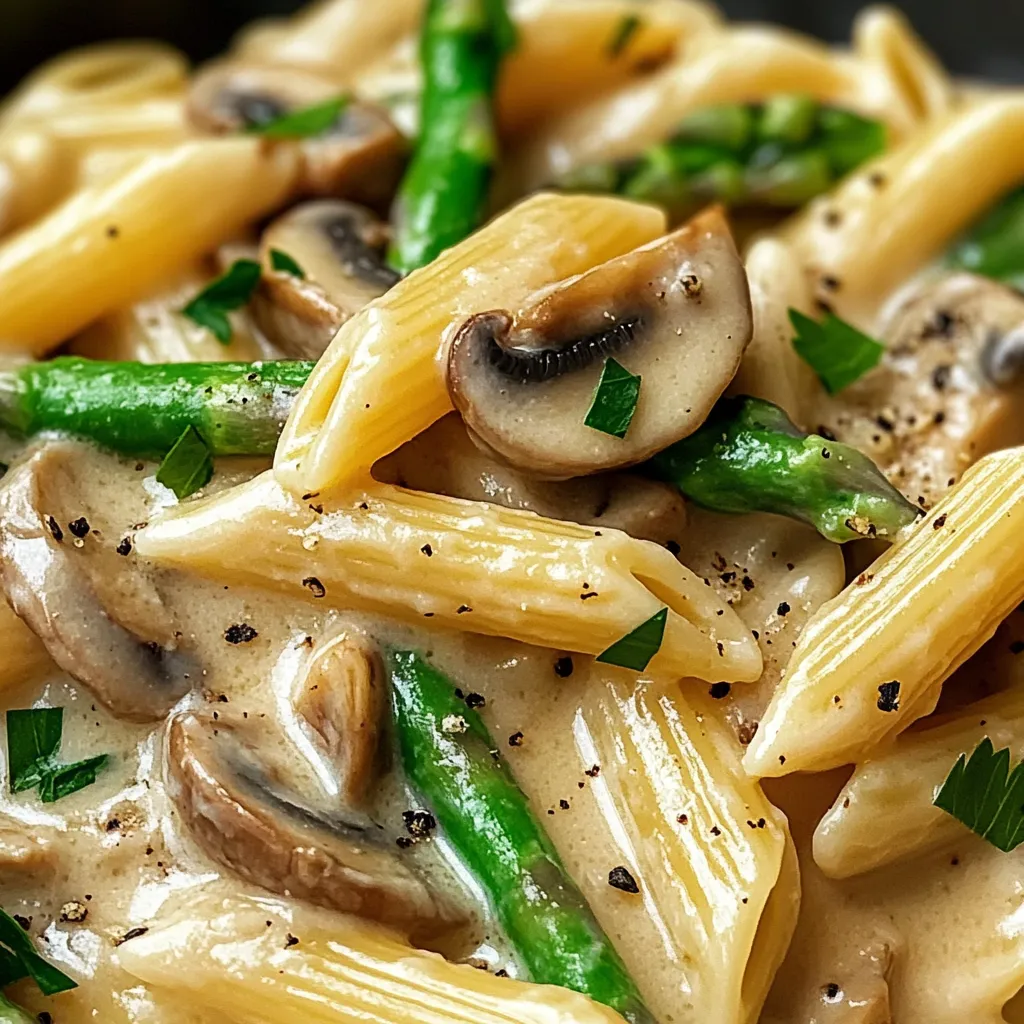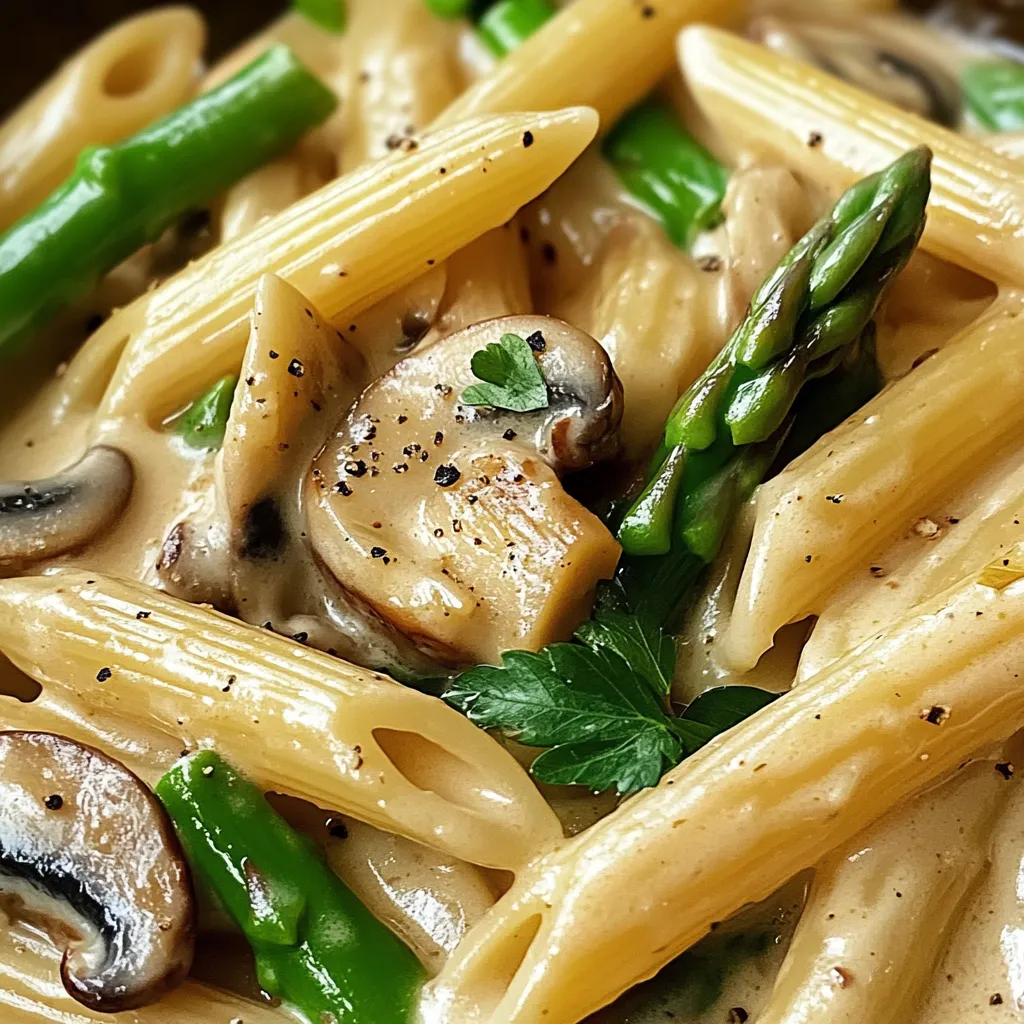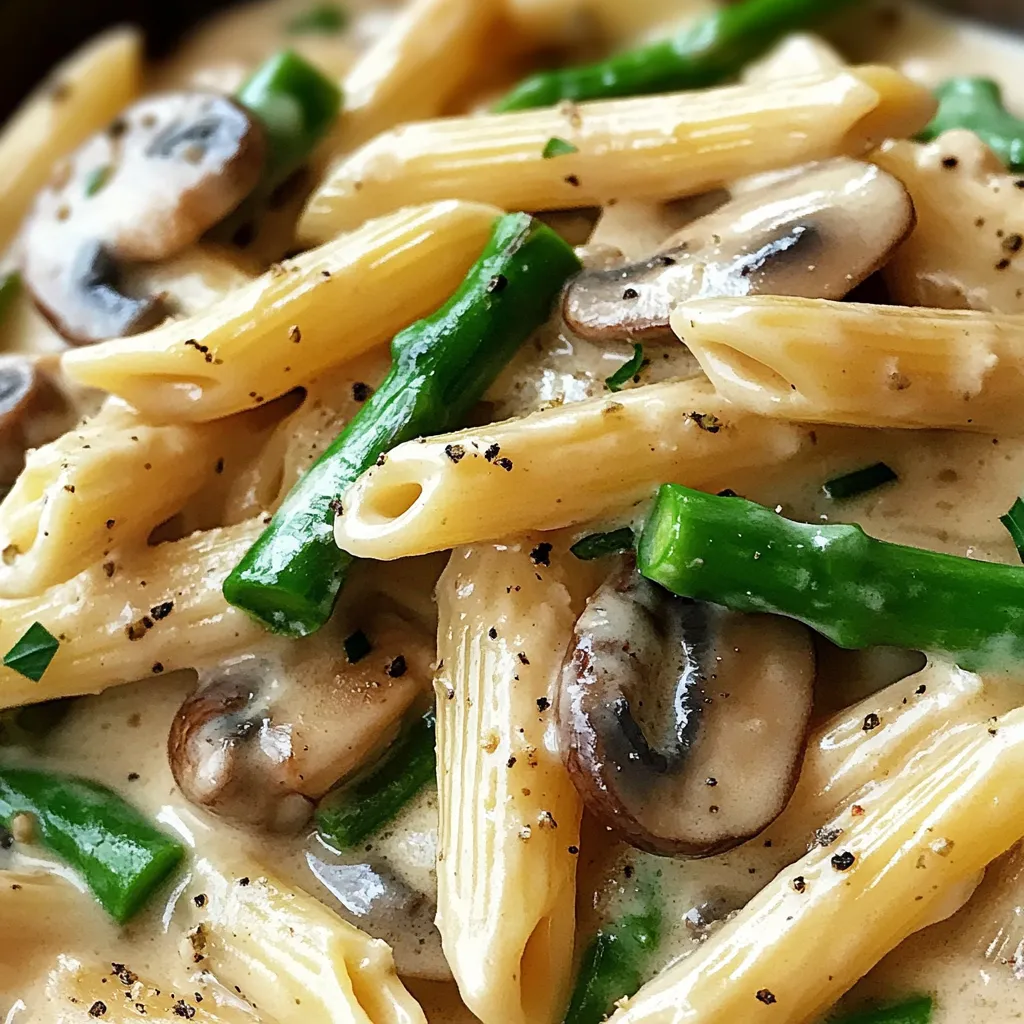 Save
Save
Creamy mushroom and asparagus chicken penne delivers cozy comfort in every forkful, transforming simple ingredients into a restaurant-worthy meal right at home. The velvety sauce clings perfectly to the ridged pasta while tender chicken pieces and vegetable medley create textural interest throughout the dish. This one-pan wonder balances rich creaminess with earthy mushrooms and bright asparagus for a satisfying dinner that feels special without requiring complicated techniques.
I discovered this pasta combination during a rainy evening when I craved something comforting yet substantial. The way the sauce coated each piece of penne while the vegetables added both nutrition and visual appeal made it an instant family favorite. My husband, typically indifferent about pasta dishes, requested it again the very next week—the ultimate culinary compliment.
Perfect Pasta Components
- Penne pasta: The tubular shape with ridged exterior captures sauce beautifully both inside and out. Cook just until al dente as it continues softening in the sauce.
- Chicken breast: Slice against the grain after cooking for maximum tenderness. Boneless thighs make an excellent substitute for juicier results.
- Cremini mushrooms: Their deeper flavor compared to white button varieties adds significant umami depth. Slice uniformly for even cooking.
- Asparagus: Choose medium-thickness spears that maintain some texture after cooking. Trim woody ends and slice diagonally for both presentation and texture.
- Garlic: Fresh cloves provide sharper flavor than pre-minced options. Slice rather than mince for noticeable bursts of flavor throughout the dish.
- Heavy cream: Creates the luxurious sauce base without requiring flour as a thickener. The high fat content prevents curdling when simmered.
- Parmesan cheese: Freshly grated melts more smoothly than pre-packaged. The aged flavor adds complexity that elevates the entire dish.
- Chicken broth: Adds depth to the sauce while preventing it from becoming too thick. Low-sodium varieties allow better seasoning control.
- Italian seasoning: This herb blend provides complex flavor from a single ingredient. The mixture of basil, oregano, thyme, and rosemary complements all components.
Pasta Perfection
Pasta Preparation: Cook penne in heavily salted water until firm to the bite. Slightly undercook as it will continue softening in the sauce. Reserve a cup of cooking water before draining to adjust sauce consistency later if needed.
Chicken Technique: Season chicken pieces generously before cooking to build flavor foundation. Allow pieces to develop golden crust before turning to ensure proper caramelization. Remove from pan slightly underdone as it will finish cooking when returned to the sauce.
Mushroom Mastery: Cook mushrooms in a single layer without overcrowding to promote browning rather than steaming. Allow them to release and then reabsorb their moisture for concentrated flavor and improved texture. This patience develops significant depth.
Asparagus Addition: Add asparagus after mushrooms have browned to prevent overcooking. The brief cooking period maintains vibrant color and pleasant texture while still incorporating flavors from the pan.
Sauce Creation: Deglaze the pan with broth, scraping up browned bits that contain concentrated flavor. Add cream gradually while stirring to prevent temperature shock. Simmer gently rather than boiling to avoid breaking the cream sauce.
Cheese Integration: Remove pan from heat before adding parmesan to prevent graininess. The residual warmth melts the cheese perfectly without risking separation. Stir continuously during addition for smoothest incorporation.
 Save
Save
My first attempt at this recipe taught me the importance of cooking sequence. Initially adding all vegetables simultaneously resulted in perfect mushrooms but mushy asparagus. I've since learned that staggering additions based on cooking times creates perfect texture throughout every component.
The key to achieving restaurant-quality results lies in understanding how cream-based sauces behave. My early versions sometimes separated or became grainy until I discovered the importance of temperature control. Now I warm the cream slightly before adding it to the hot pan and remove from heat before incorporating cheese—simple adjustments that ensure silky results every time.
For maximum flavor development, I've learned to be patient with the mushrooms. Allowing them proper space and time to release their moisture and then brown creates significantly more complex flavor than rushing this step. The initial patience pays dividends in the final taste experience.
Perfect Pairings
This creamy pasta dish welcomes thoughtful accompaniments that balance its richness. A simple arugula salad dressed with lemon juice and olive oil provides refreshing contrast while the peppery greens cut through the cream sauce beautifully.
For a complete meal experience, serve alongside garlic bread made with good quality sourdough. The crusty exterior and chewy interior create textural contrast while providing the perfect vehicle for capturing extra sauce from your plate.
Consider opening a bottle of crisp white wine like Pinot Grigio or unoaked Chardonnay whose acidity balances the creamy richness. The bright notes complement the vegetables while standing up to the substantial sauce for perfect flavor harmony.
Tasty Twists
Transform this dish with seasonal adaptations using vegetables currently at their peak. Summer versions might include cherry tomatoes and zucchini, while fall iterations could incorporate butternut squash and sage for completely different flavor profiles while maintaining the basic technique.
Create a seafood variation by substituting shrimp or scallops for chicken. These cook even more quickly while offering delicate sweetness that pairs beautifully with the cream sauce. Adjust cooking time accordingly to prevent overcooking delicate seafood.
Develop vegetarian adaptations by omitting chicken and doubling mushroom quantity for substantial meatiness. Adding toasted walnuts provides protein and textural contrast that makes the dish satisfying even without animal protein.
Storage Smarts
Store leftovers in airtight containers for up to three days in the refrigerator. The flavors actually improve overnight as ingredients continue melding. Add a splash of milk or cream when reheating to refresh the sauce consistency.
Prepare components ahead of time for easy weeknight assembly. Cook chicken and vegetables separately, then refrigerate until needed. Prepare pasta fresh before combining with reheated components and freshly made sauce for quick dinnertime preparation.
Freeze fully assembled portions in oven-safe containers for future meals. Thaw overnight in refrigerator, then bake covered until heated through. The texture remains surprisingly good, though asparagus will soften slightly more than in freshly made versions.
The beauty of this mushroom asparagus penne lies in its versatility and impressive presentation despite straightforward preparation. While it looks and tastes like something requiring culinary training, anyone can master this satisfying pasta dish with minimal effort. I particularly appreciate how it transforms everyday ingredients into something that feels special enough for entertaining yet remains accessible for regular weeknight cooking. The balanced combination of protein, vegetables, and comforting pasta makes this creamy dish something I return to repeatedly, both for family dinners and when hosting friends who inevitably request the recipe before the evening ends.
 Save
Save
Common Questions About Cooking
- → Can I use a different pasta shape?
- Absolutely! While penne works great because the sauce gets inside the tubes, you can substitute any pasta you have on hand. Fettuccine, rigatoni, or bow ties all work well with this creamy sauce.
- → What can I substitute for heavy cream?
- Half-and-half makes a good lighter substitute, though the sauce won't be quite as rich. For a dairy-free option, full-fat coconut milk works surprisingly well, though it will add a slight coconut flavor.
- → Can I make this ahead of time?
- This dish is best served fresh, but you can prep all the ingredients ahead of time. If you need to reheat leftovers, add a splash of milk or cream and warm gently on the stove to prevent the sauce from separating.
- → What vegetables can I substitute for asparagus?
- Broccoli, peas, zucchini, or spinach all work great in this recipe. Just adjust cooking times accordingly - spinach only needs about 30 seconds to wilt, while broccoli might need 3-4 minutes to become tender.
- → Is there a way to make this gluten-free?
- Yes! Simply swap the regular penne for your favorite gluten-free pasta. Just check that it's cooked al dente, as some gluten-free pastas can get mushy if overcooked. Everything else in the recipe is naturally gluten-free.
